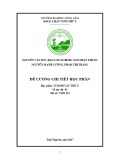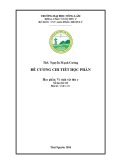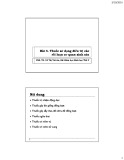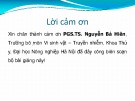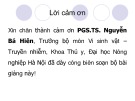Streptococci
• Characters of Streptococci
• Cầu khuẩn, Gram + • Đường kính 1µm • Chuỗi • Thương có vỏ bọc • Không di động • Không sinh nha bào Nuôi cấy • Yếm khí tùy tiện • Khó tính • Catalase negative (Staphylococci are catalase positive)
Classification of Streptococci
• Streptococci can be classified according to:
• Oxygen requirements (Cần oxy)
• Anaerobic (Peptostreptococcus) • Aerobic or facultative anaerobic (Streptococcus)
• Serology (Lanciefield Classification) • Hemolysis on Blood Agar (BA)
Serology: Lanciefield Classification
Streptococci
Lanciefield classification
Group A
Group B
Group C
Group D
Other groups
S. pyogenes
S. agalactiae
S. equisimitis
Enterococcus
(E-U)
• Streptococci classified into many groups from A-K & H-V • One or more species per group • Classification based on C- carbohydrate antigen of cell wall
• A, B and D (more frequent) • C, G and F (Less frequent) • Non-groupable streptococci • S. pneumoniae (pneumonia) • viridans streptococci • e.g. S. mutans • Causing dental carries
• Groupable streptococci
Classification of Streptococci Based on Hemolysis on Blood Agar
Hemolysis on BA – -hemolysis
Partial hemolysis Green discoloration around the colonies e.g. non-groupable streptococci (S. pneumoniae& S. viridans)
Complete hemolysis Clear zone of hemolysis around the colonies e.g. Group A & B (S. pyogenes& S. agalactiae)
– -hemolysis
Streptococci
-hemolysis
-hemolysis
-hemolysis
– -hemolysis No lysis e.g. Group D (Enterococcus spp)
Hemolysis on Blood agar
-hemolysis
-hemolysis
-hemolysis
Group A streptococci
• Include only S. pyogenes • Group A streptococcal infections affect all ages peak incidence
at 5-15 years of age (lứa tuổi mắc ở người 5-15 tuổi)
• 90% of cases of pharyngitis (viêm họng)
Pathogenesis and Virulence Factors
• Structural components
• M protein M, which interferes with opsonization and lysis of the bacteria • Lipoteichoic acid & F protein adhesion • Hyaluronic acid capsule, which acts to camouflage the bacteria
• Enzymes
facilitate the spread of streptococci through tissues
• Pyrogenic toxins that stimulate macrophages and helper T cells
to release cytokines
• Streptolysins
• Streptokinases • Deoxynucleases • C5a peptidase
• Streptolysin O lyse red blood cells, white blood cells, and platelets • Streptolysin S
Opsonization
Disease caused by S. pyogenes
• Suppurative (sự sinh mủ)
• Non-Invasive
• Invasive
• Pharyngitis (“strep throat”)-inflammation (viêm họng) of the pharynx • Skin infection, Impetigo (bệnh chốc lở)
• Scarlet fever-rash (sốt ban đỏ) that begins on the chest and spreads across
the body
on the face, arms, or legs
• Pyoderma-confined, pus-producing lesion (viêm da mủ) that usually occurs
• Necrotizing fasciitis-toxin production (độc tố gây viêm cơ da hoại tử)
• Non Suppurative
destroys tissues and eventually muscle and fat tissue
leads to damage of heart valves muscle • Glomerulonephritits (viêm tiểu cầu thận) • Immune complex disease of kidney • inflammation of the glomeruli and nephrons which obstruct blood flow
• Rheumatic fever (sốt thấp khớp): Life threatening inflammatory disease that
through the kidneys
Differentiation between -hemolytic streptococci
• The following tests can be used to differentiate between -hemolytic streptococci • Lanciefield Classification • Bacitracin susceptibility Test
• Specific for S. pyogenes (Group A)
• CAMP test
• Specific for S. agalactiae (Group B)
Bacitracin sensitivity
• Principle:
• Bacitracin test is used for presumptive
identification of group A
• To distinguish between S. pyogenes (susceptible
to B) & non group A such as S. agalactiae (Resistant to B)
• Inoculate BAP with heavy suspension of tested
• Bacitracin will inhibit the growth of gp A Strep. pyogenes giving zone of inhibition around the disk • Procedure:
organism
• Bacitracin disk (0.04 U) is applied to inoculated
BAP
• After incubation, any zone of inhibition around
the disk is considered as susceptible
CAMP test
• Principle:
• Procedure:
• Single streak of Streptococcus to be tested and a Staph. aureus are made
• Group B streptococci produce extracellular protein (CAMP factor) • CAMP act synergistically with staph. -lysin to cause lysis of RBCs
perpendicular to each other
• 3-5 mm distance was left between two streaks • After incubation, a positive result appear as an arrowhead shaped zone of
• S. agalactiae is CAMP test positive while non gp B streptococci are negative
complete hemolysis
CAMP test
Differentiation between -hemolytic streptococci
• The following definitive tests used to differentiate between S. pneumoniae & viridans streptococci
• Optochin Test • Bile Solubility Test • Inulin Fermentation
Optochin Susceptibility Test
• Principle:
pneumoniae
• Optochin (OP) test is presumptive test that is used to identify S.
• S. pneumoniae is inhibited by Optochin reagent (<5 µg/ml) giving a
• Procedure:
• BAP inoculated with organism to be tested • OP disk is placed on the center of inoculated BAP • After incubation at 37oC for 18 hrs, accurately measure the diameter
inhibition zone ≥14 mm in diameter.
of the inhibition zone by the ruler
and ≤13 mm is considered negative
• S. pneumoniae is positive (S) while S. viridans is negative (R)
• ≥14 mm zone of inhibition around the disk is considered as positive
Optochin Susceptibility Test
Optochin resistant S. viridans
Optochin susceptible S. pneumoniae
Bile Solubility test
• Principle:
• S. pneumoniae produce a self-lysing enzyme to inhibit the
growth
• The presence of bile salt accelerate this process
• Procedure:
• Add ten parts (10 ml) of the broth culture of the organism to be tested to one part (1 ml) of 2% Na deoxycholate (bile) into the test tube
• Negative control is made by adding saline instead of bile to
the culture
• Incubate at 37oC for 15 min • Record the result after 15 min
Bile Solubility test
• Results:
• Positive test appears as clearing
(trong) in the presence of bile while negative test appears as turbid (đục)
• S. pneumoniae soluble (hòa tan) in bile whereas S. viridans insoluble
Differentiation between -hemolytic streptococci
Hemolysis CAMP test
Bacitracin sensitivity
S. pyogenes Susceptible Negative
Differentiation between -hemolytic streptococci
S. agalactiae Resistant Positive
Hemolysis
Soluble
Not ferment
Optochin sensitivity Bile solubility Inulin Fermentation
Sensitive (≥ 14 mm)
Insoluble
Ferment
S. pneumoniae
Resistant (≤13 mm)
Viridansstrep
Outline of differentiation between Gram-Positive cocci
e.g. S. epidermidis





